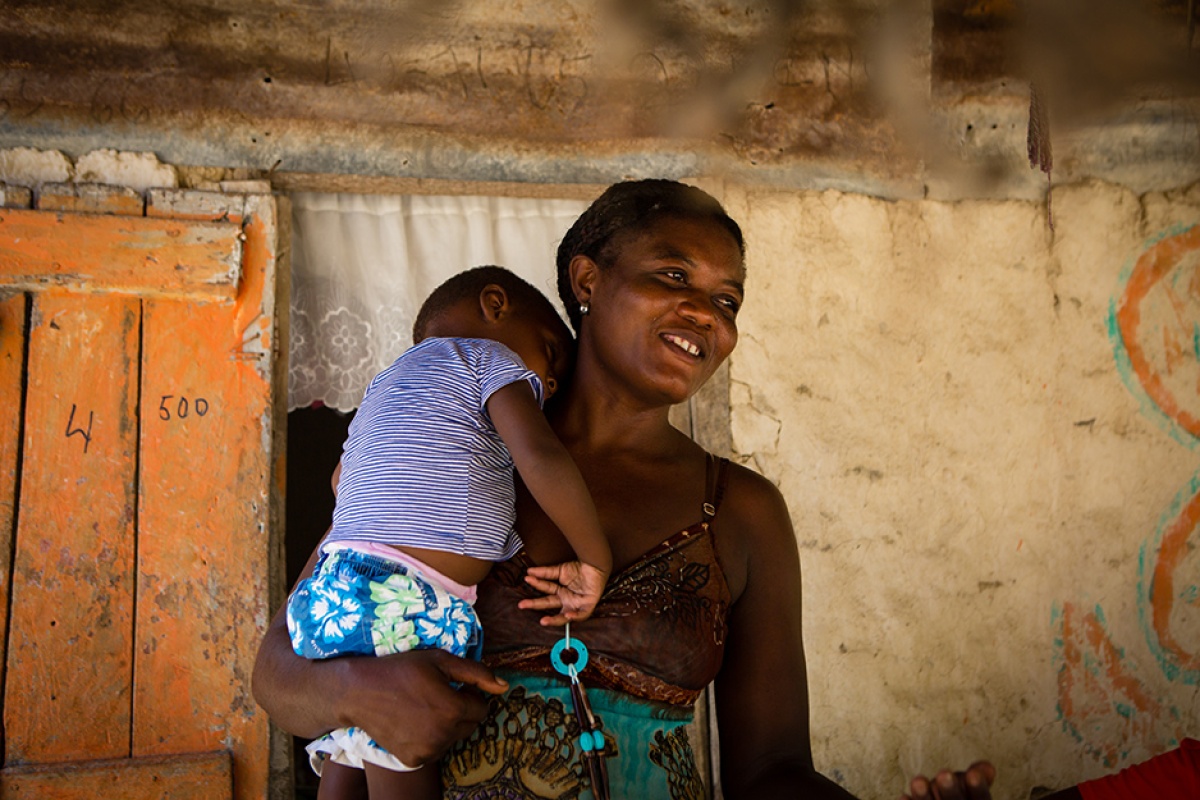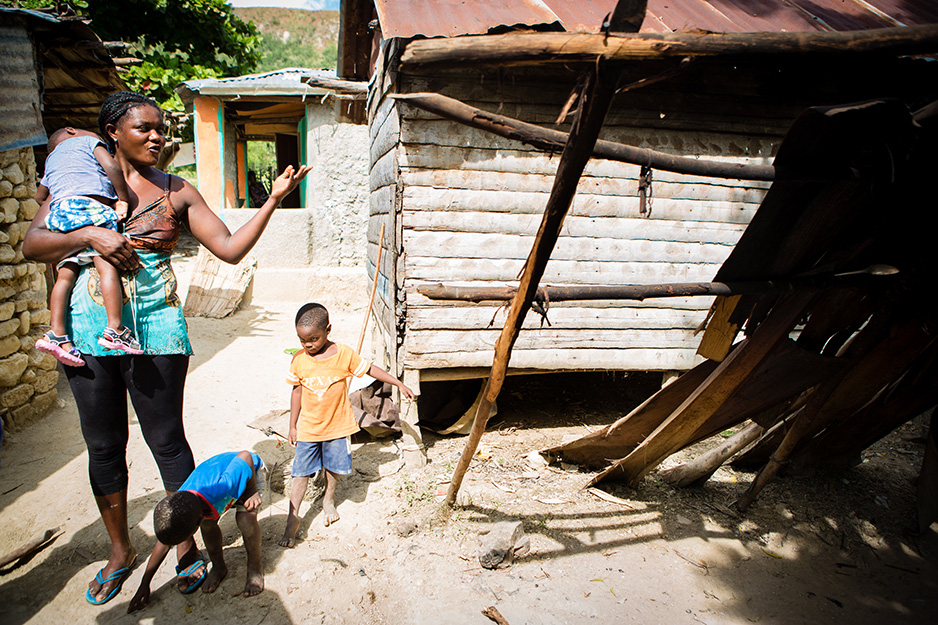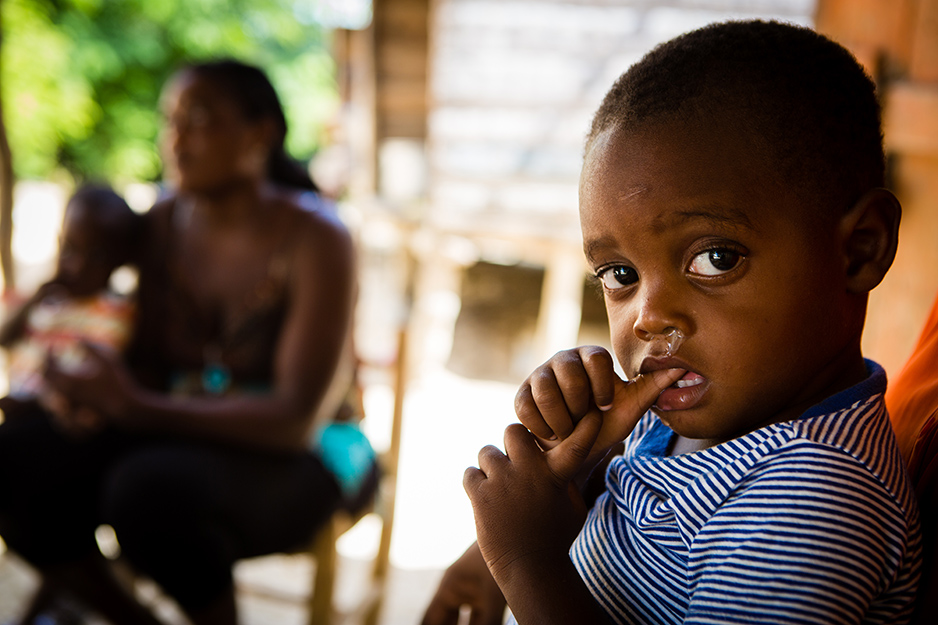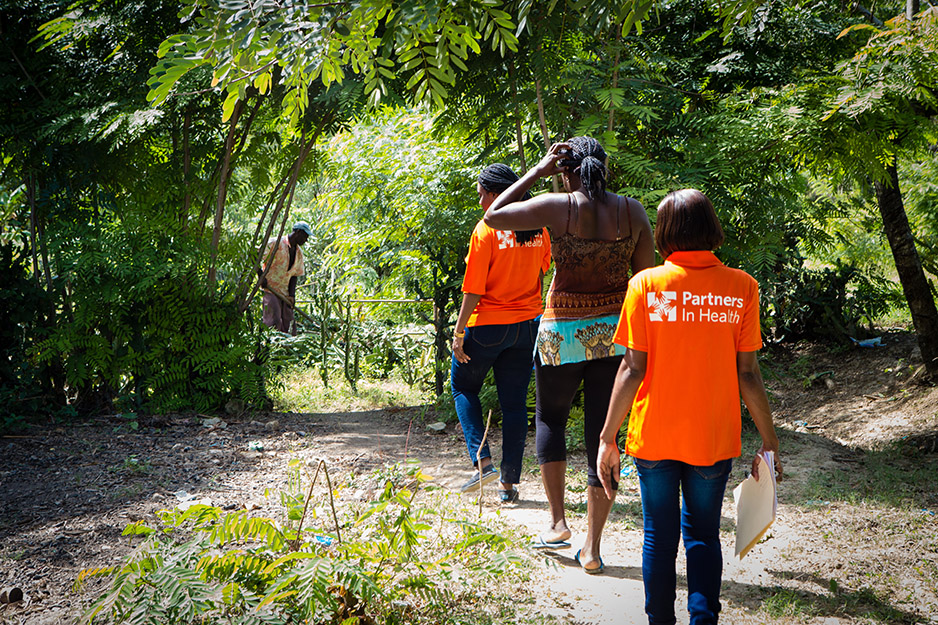Visiting Djouvensky, a Malnutrition Patient in Haiti
Posted on Oct 4, 2017

The Partners In Health pickup bumped along a rutted road, passing more cows than vehicles on a late morning last November. The driver parked in the shade of a lone tree, and 29-year-old Yonide Arelul and two PIH nurses stepped out of the cab and into the blinding sun.
It was the literal end of the road—for vehicles, anyway—so the women trekked carefully down a rocky slope, crossed a stream, and continued hiking the rough-hewn path through the lush hillside beyond.
One of Arelul’s children was enrolled in PIH’s malnutrition program at the clinic in Boucan Carré, Haiti, where Ms. Asmine Pierre is lead nurse, and Ms. Esther Mahotierre supervises as the nutrition program coordinator. The staff with Zanmi Lasante, as PIH is known in Haiti, wanted to check on the boy’s progress, but had no idea where the family lived. So Arelul walked to the clinic that morning, then mounted the pickup alongside the nurses for the first leg of the trip, and led them the rest of the way on foot.
Roughly 1 in 5 children are starving in Haiti.
Arelul, and many rural Haitians like her, overcome barriers like these every day to access health care. When PIH clinicians see them arrive at a clinic, they know the patients are in desperate need of help.
Roughly 1 in 5 children are starving in Haiti, and 1 in 3 are stunted because they don’t have enough to eat. Arelul’s son, Djouvensky Maxime, was one of the 127 patients, on average, who visited the malnutrition clinic in Boucan Carré every month last year to receive a food supplement and nursing care. That’s just a fraction of the total number of starving children PIH helps. Altogether, 9,000 such children were new patients at PIH-supported clinics and hospitals across the country in 2016.
Arriving home
The sun felt piercingly hot. Pierre held a manila folder above her head in self-defense as she and Mahotiere trailed behind Arelul. Papaya trees and sugar cane seemed to bow in the heat. A farmer and his horse ambled past, laden with burlap sacks of homemade charcoal. Farther up the path, a group of schoolchildren in checkered shirts and neatly tied hair ribbons chattered on their way home for lunch.
Twenty minutes in, Arelul veered off the path. She crossed her family’s compound, seeking the shade of the banana-leaf awning attached to her two-room home. Her mother was bathing Djouvensky in the dirt courtyard. He stood in a pink plastic tub, his short-cropped hair catching drops of water poured over his head with an empty container of Nourimanba, a nutrient-rich peanut paste PIH manufactures for malnourished children. Once dried and dressed, he tucked himself into his mother’s lap and soon fell asleep.
Djouvensky’s twin brother, Djouven, stood nearby like a sentinel—curious about the visitors, yet protective of his brother. The 23-month-old boys were nearly the same size and are Arelul’s babies. She has five children altogether. Her 9-year-old daughter was studying in Mirebalais, and a pair of 4-year-old twin boys played in the shade nearby.
Arelul adjusted Djouvensky so that his head rested on her shoulder. He was her “sick” child, the one who nearly died from malnutrition.

Some children graduate from the malnutrition program within several months by gaining enough weight and height to place them back on a normal growth curve. Others don’t complete the program the first time around. Last year alone, of the nearly 8,000 children enrolled in PIH’s severe malnutrition program, 50 percent dropped out. Their families live far from the nearest clinic and can’t afford transportation. Sometimes one parent is caring for multiple children at home, and can’t slip away for appointments. Other times, families have nothing to feed their children beyond Nourimanba, which is meant to supplement—not replace—a child’s normal diet.
Arelul faces these challenges, and others, in getting Djouvensky the care he needs. Her husband works in Port-au-Prince as a welder and comes home once a month. She relies on her parents for help, but they—like many of their neighbors—are subsistence farmers and spend long hours tending their crops and livestock. So most days, she alone cooks, cleans, and cares for her children, and tends her own fields.
Daily life is a blur for mothers like Arelul, who don’t have the luxury of choosing what is best for their children. They often get by on good enough.
A rough beginning
With her last pregnancy, Arelul didn’t have time for regular prenatal visits. She was nearly full-term when she went into labor. Her family ran for the local birth attendant so that she could deliver at home, like two-thirds of women in Haiti, and she gave birth to a healthy son. But something wasn’t right. Her placenta wasn’t descending, and she was still in an immense amount of pain. The birth attendant recommended she go to the nearest clinic. For that, she would need a minor miracle, and some strong backs.
A crew of men were rounded up. Together they lifted the mattress on which Arelul labored and hoofed it, double time, to Boucan Carré. Normally, the walk takes about an hour; that day, it took 30 minutes. Doctors examined the distraught mother and provided her with surprising news: there was another baby. She gave birth to her second son minutes later.
He had nearly fallen below both growth curves and needed immediate medical attention.
Djounvensky was the smaller of the two. He wasn’t growing like his brother and always seemed sick. Arelul took him to the Boucan Carré clinic, where he was referred to the malnutrition program. Nurses diagnosed him as severely malnourished and started him on treatment. But he just didn’t seem to be getting better, which made his mother wonder if the sacrifices she’d been making to get him there were worthwhile. She decided to stop attending the weekly clinic visits.
Instead, the family took Djouvensky to a cousin, a local traditional healer. They were thinking he wasn’t “doctor sick,” but possibly under the influence of darker forces. The cousin provided them with treatment, but encouraged them to return to the clinic. They did. That cycle repeated again as the boy’s parents became increasingly frustrated. The toddler still couldn’t walk or talk and was lethargic, while his twin brother ran around, chatted, and made mischief. Her husband was ready to give up on Djouvensky.
For Arelul, that was not an option. She arrived at the clinic a third time with Djouvensky last November. Just shy of 2 years old, he weighed 22 pounds and measured 31 inches. According to World Health Organization growth standards, he should have been 27 pounds and 35 inches—in other words, he had nearly fallen below both growth curves and needed immediate medical attention.
The turning point

Pierre and her team placed Djouvensky on Nourimanba and scheduled him to return to the clinic every eight days so they could replenish his stock of peanut paste and weigh him. Arelul stuck with the program this time, spoon-feeding him Nourimanba three times a day and attending all his appointments. Sometimes she took the family’s horse and rode with Djouvensky to the clinic. On market days, when her mother needed the animal to haul corn, potatoes, and rice, Arelul hired a motorcycle driver to take them. If all else failed, she carried Djouvensky on her back.
Her diligence paid off. Djouvensky began to walk. He played more with his twin. He even said his first word, “Mama.”
Pierre, who was sitting near Arelul in the shade during the home visit nearly a year ago, paged through Djouvensky’s file and confirmed that his condition had improved from severely to moderately malnourished over just a couple of weeks. It was a small adjustment in language, but a huge difference in the boy’s daily life—and future potential.
In that moment, though, Djouvensky had no idea he was the center of attention. He was just waking up from deep sleep. He stuck his thumb in his mouth, walked over to Pierre, and snuggled on her lap. Shy and quiet, he stared at visitors with saucer-like brown eyes. His skin shone. His cheeks looked full. He had many weeks left of treatment, but finally, things were turning in his favor.
Arelul stood to escort Pierre and Mahotiere back to the main path. The sun was still punishing as the nurses retraced their steps to the pickup. At the base of the last hill, they paused beside a front-loader parked by a stream. Someday, the machine would be used to carve the rest of the gravel road, connecting rural residents more quickly to health care in the town clinic.
But that was far in the future. Pierre and Mahotiere had many more home visits to make.


